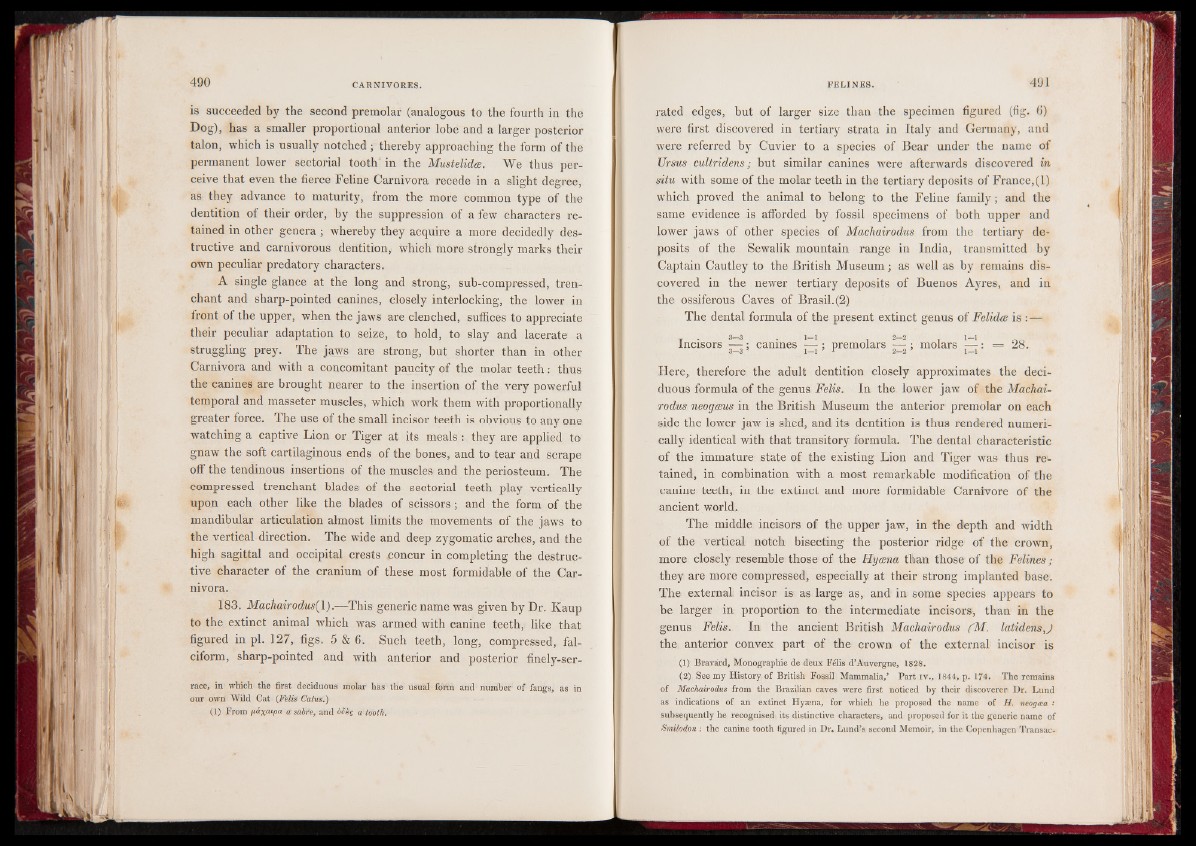
is succeeded by the second premolar (analogous to the fourth in the
Dog), has a smaller proportional anterior lobe and a larger posterior
talon, which is usually notched | thereby approaching the form of the
permanent lower sectorial tooth’ in the Mustelidce. We thus perceive
that even the fierce Feline Carnivora recede in a slight degree,
as they advance to maturity, from the more common type of the
dentition of their order, by the suppression of a few characters retained
in other genera ; whereby they acquire a more decidedly destructive
and carnivorous dentition* which more strongly marks their
own peculiar predatory characters.
A single glance at the long and strong, sub-compressed, trenchant
and sharp-pointed canines, closely interlocking, the lower in
front of the upper, when the jaws are clenched, suffices to appreciate
their peculiar adaptation to seize, to hold, to slay and lacerate a
struggling prey. The jaws are strong, but shorter than in other
Carnivora and with a concomitant paucity of the molar teeth: thus
the canines are brought nearer to the insertion of the very powerful
temporal and masseter muscles, which work them with proportionally
greater force. The use of the small incisor teeth is obvious to any one
watching a captive Lion or Tiger at its meals they are applied to
gnaw the soft cartilaginous ends of the bones, and to tear and scrape
off the tendinous insertions of the muscles and the periosteum. The
compressed trenchant blades of the sectorial teeth play vertically
upon each other like the blades of scissors; and the form of the
mandibular articulation almost limits the movements of the jaws to
the vertical direction. The wide and deep zygomatic arches, and the
high sagittal and occipital crests concur in completing the destructive
character of the cranium of these most formidable of the Carnivora.
183. Machairodus(\).—This generic name was given by Dr. Kaup
to the extinct animal which was armed with canine teeth, like that
figured in pi. 127, figs. 5 & 6. Such teeth, long, compressed, falciform,
sharp-pointed and with anterior and posterior finely-serrace,
in which the first deciduous molar has the usual form and number of fangs, as in
our own Wild Cat (Felis Catus.)
(1) From jiaxaipa a sabre, and t>S&e a tdoth.
rated edges, but of larger size than the specimen figured (fig. 6)
were first discovered in tertiary strata in Italy and Germany, and
were referred by Cuvier to a species of Bear under the name of
Ursus cultridens; but similar canines were afterwards discovered in
situ with some of the molar teeth in the tertiary deposits of France,(1)
which proved the animal to belong to the Feline family; and the
same evidence is afforded by fossil specimens of both upper and
lower jaws of other species of Machairodus from the tertiary deposits
of the Sewalik mountain range in India, transmitted by
Captain Cautley to the British Museum; as well as by remains discovered
in the newer tertiary deposits of Buenos Ayres, and in
the ossiferous Caves of Brasil. (2)
The dental formula of the present extinct genus of Felidae is :—
Incisors — ; canines — ; premolars — ; molars — : = 28. 3—3 * 1—1 ’ r 2—2 ’ l —l
Here, therefore the adult dentition closely approximates the deciduous
formula of the genus Felis. In the lower jaw of the Machairodus
neogaeus in the British Museum the anterior premolar on each
side the lower jaw is shed, and its dentition is thus rendered numerically
identical with that transitory formula. The dental characteristic
of the immature state of the existing Lion and Tiger was thus retained,
in combination with a most remarkable modification of the
canine teeth, in the extinct and more formidable Carnivore of the
ancient world.
The middle incisors of the upper jaw, in the depth and width
of the vertical notch bisecting the posterior ridge of the crown,
more closely resemble those of the Hyaena than those of the Felines;
they are more compressed, especially at their strong implanted base.
The external incisor is as large as, and in some species appears to
be larger in proportion to the intermediate incisors, than in the
genus Felis. In the ancient British Machairodus fM. latidensj
the anterior convex part of the crown of the external incisor is
(1) Bravard, Monographie de deux Felis d’Auvergne, 1828.
(2) See my History of British Fossil Mammalia,’ Part iv., 1844, p. 174. The remains
of Machairodus from the Brazilian caves were first noticed by their discoverer Dr. Lund
as indications of an extinct Hyaena, for which he proposed the name of H. neogosa :
subsequently he recognised its distinctive characters, and proposed for it the generic name of
Smilodon : the canine tooth figured in Dr. Lund’s second Memoir, in the Copenhagen Transac